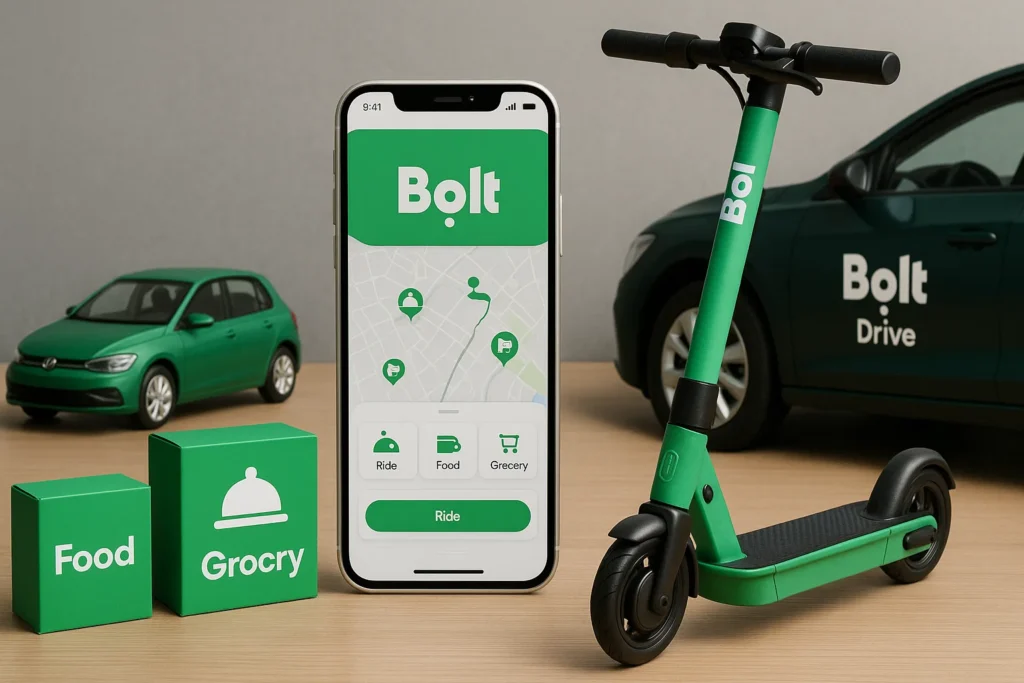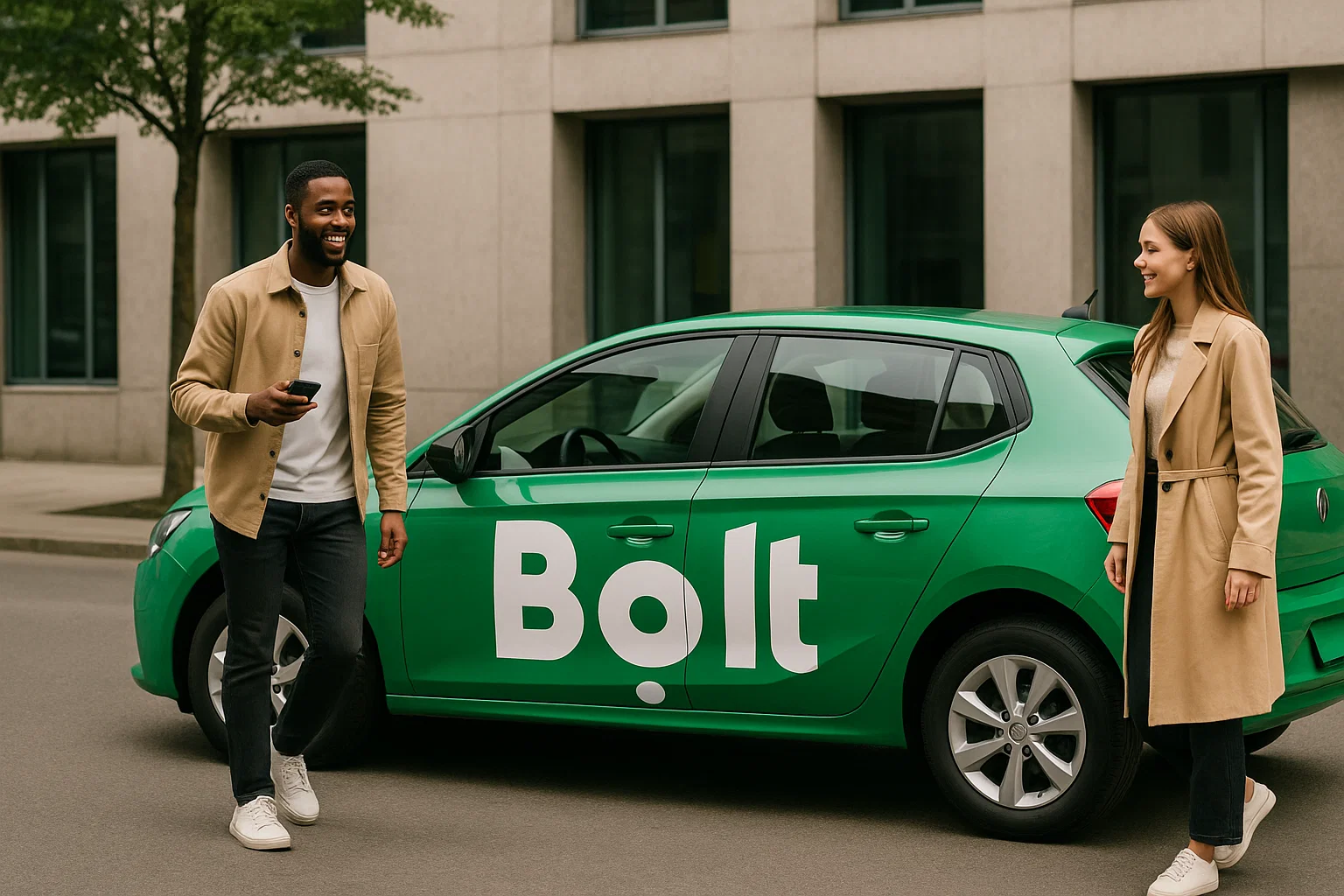Bolt has emerged as one of the fastest-growing mobility platforms in Europe, disrupting the ride-hailing, scooter-sharing, food delivery, and even grocery sectors — all from a single app. Dubbed the “Uber alternative for Europe and beyond,” Bolt is now active in over 45 countries, serving millions of users and drivers with a sharp focus on affordability and speed.
With a $8.4 billion valuation (as of 2024) and an expanding portfolio of services — including Bolt Ride, Bolt Food, Bolt Market, and Bolt Drive — the company has crafted a versatile and scalable revenue model that appeals to both urban consumers and gig-economy workers.
In this blog, we’ll explore how Bolt earns money across its various business verticals, why its revenue model is relevant in 2025, and how Miracuves empowers startups to replicate this success with a feature-rich Bolt clone solution.
How Bolt Makes Money
Bolt generates revenue through multiple urban mobility and delivery verticals, each with its own monetization stream. Here’s a breakdown of the core ways Bolt earns money:
- Ride-Hailing Commissions – Takes a percentage cut (typically 15–20%) from each ride booked through the app.
- Food Delivery Fees – Charges both restaurants and customers through commissions and delivery fees.
- Grocery Delivery (Bolt Market) – Earns via product markups and delivery charges from dark stores.
- Micromobility Rentals – Offers electric scooter and e-bike rentals by the minute with unlock fees.
- Car Sharing (Bolt Drive) – Generates hourly or daily rental income from short-term car rentals.
- Advertising and Promotions – Brands can promote themselves on the platform via Bolt Business, sponsored placements, or loyalty integrations.
- Subscription Services – Offers benefits like discounted rides or free unlocks for a monthly fee (e.g., Bolt Pass in some regions).
- Corporate Mobility Solutions – Monetizes via fleet services, employee rides, and business accounts under Bolt Business.

Each vertical contributes to a flywheel effect — the more users rely on Bolt for multiple services, the more revenue streams activate per user.
From quick rides to eco-friendly scooters, Bolt is more than just a taxi app—explore how Bolt works to simplify urban travel.
Detailed Breakdown of Revenue Channels
Ride-Hailing Commissions
Bolt charges drivers a commission on each completed ride, typically ranging between 15–20%, which is slightly lower than Uber’s 25–30%. This lower commission attracts more drivers, increasing supply and allowing Bolt to offer competitive prices — driving user growth.
- Who Pays? Drivers
- Why It Scales? High-volume, low-margin model with regional flexibility and instant liquidity
Food Delivery Fees
Bolt Food operates similarly to platforms like DoorDash or Uber Eats. It takes a commission from restaurants (typically 20–30%) and may charge customers a delivery or service fee depending on location and order size.
- Who Pays? Both restaurants and end-users
- Why It Scales? Two-sided marketplace monetization with room for upsells and add-ons
Grocery Delivery (Bolt Market)
Bolt Market operates “dark stores” — local warehouses where groceries are picked and delivered quickly. Revenue comes from product markups, convenience/delivery fees, and optimized supply chain margins.
- Who Pays? End customers
- Why It Scales? Control over inventory, faster delivery, and higher margins vs. traditional food delivery
Micromobility Rentals
Bolt’s e-scooters and bikes are rentable via the app. Users pay a small unlock fee (e.g., €1) and then a per-minute usage rate. This model thrives in urban centers with high foot traffic and short commutes.
- Who Pays? Riders
- Why It Scales? High margin after fixed asset breakeven; usage grows with city adoption
Car Sharing (Bolt Drive)
Bolt Drive offers short-term car rentals with flexible pricing — hourly, daily, or per km. Revenue is generated per trip, and users book, unlock, and end trips via the app.
- Who Pays? Individuals or business users
- Why It Scales? Asset-light partnerships + increased urban need for flexible transport options
Advertising and Promotions
Bolt monetizes attention on its platform by offering sponsored listings, homepage features, or branded campaigns through Bolt Business. Restaurants, brands, and local vendors pay for visibility and targeted promotions.
- Who Pays? B2B advertisers and partners
- Why It Scales? Non-transactional revenue stream that grows with app usage
Subscription Services
In some cities, Bolt offers Bolt Pass — a subscription model where users pay a flat monthly fee for discounted rides or free unlocks. This model drives loyalty and predictable recurring revenue.
- Who Pays? Power users and commuters
- Why It Scales? Reduces churn and creates a stable income layer
Corporate Mobility Solutions
Under Bolt Business, the platform serves enterprises with scheduled transport, fleet management, and employee ride billing. Businesses are billed monthly or per-ride based on corporate usage.
- Who Pays? Corporate clients
- Why It Scales? Larger ticket sizes and recurring B2B contracts
With real-time tracking, multiple payment options, and safety tools, Bolt leads by example—discover the key features of Bolt worth replicating.
Why This Revenue Model Works in 2025
Bolt’s revenue model is uniquely positioned to thrive in today’s fast-evolving mobility landscape. Its multi-service approach and tech-first execution align with emerging urban trends, consumer preferences, and macroeconomic shifts.
Urbanization and On-Demand Expectations
With more people living in cities, the demand for flexible, on-demand transport and delivery services is soaring. Bolt’s ride-hailing, micromobility, and delivery services offer convenience without ownership — a big win for eco-conscious urban users.
Affordability as a Market Advantage
Bolt’s lower commissions and customer pricing allow it to remain cost-effective compared to competitors. In markets sensitive to pricing — like Eastern Europe, Africa, and parts of Asia — this makes it the go-to app for both riders and drivers.
Multi-Vertical Synergy
By integrating ride-hailing, food delivery, grocery, and micromobility in one super app, Bolt maximizes user lifetime value. A customer who books a ride today might rent a scooter tomorrow or order lunch via Bolt Food — boosting cross-sell and retention.
Subscription and Loyalty Ecosystems
With Bolt Pass and other recurring models, the platform builds loyalty while securing predictable revenue. In a world where CAC (customer acquisition cost) is rising, these programs lower churn and enhance user value.
Sustainability Trends
Bolt’s electric scooters, bikes, and EV-friendly policies appeal to eco-conscious users and cities alike. As regulations tighten around emissions and congestion, Bolt’s sustainability-first positioning makes it a preferred partner for governments and riders.
Bolt grew by mixing affordability with aggressive expansion—explore the Bolt marketing strategy that keeps it ahead of rivals.
Can Startups Replicate Bolt’s Revenue Model?
Yes — but only with the right infrastructure, integrations, and go-to-market strategy.
Replicating Bolt’s diverse revenue model requires more than just a ride-hailing app. You need a scalable, multi-vertical platform that handles real-time logistics, third-party integrations, map APIs, dynamic pricing, fleet management, and user wallets — all while delivering a seamless UX for both customers and service providers.
That’s where Miracuves makes all the difference.
With our ready-to-launch Bolt Clone solution, startups, SaaS founders, and digital agencies can build a fully functional super app without starting from scratch. Our clone is built with:
- Integrated ride-hailing, food delivery, scooter/bike rental, and car-sharing modules
- Admin panels for dynamic commission control, pricing, and promotions
- Driver and merchant onboarding systems
- Real-time tracking, wallet, and payout features
- Subscription models and loyalty integrations (like Bolt Pass)
- Scalable architecture for multi-city or international expansion
Instead of spending years developing a fragmented ecosystem, Miracuves helps you deploy a future-ready mobility platform — with built-in monetization levers already proven by Bolt.
The Bolt Clone by Miracuves is priced at $2,899, crafted for ride-hailing and micro-mobility businesses.
Launch cab, bike, and scooter rental services with real-time tracking and seamless management.
Go live in just 3–6 days with 60 days of tech support.
Launching your own ride-hailing platform starts with the best Bolt clone scripts in 2025, gets technical with our developer guide to building a Bolt-like app, and becomes achievable when you plan smart using the Bolt app development cost guide.
Conclusion
Bolt’s revenue model stands as a blueprint for modern, urban mobility success. By combining commissions, delivery fees, rentals, advertising, subscriptions, and corporate solutions — Bolt has built a multi-stream income engine that thrives across countries and customer segments.
Its ability to layer new services onto an existing user base — while staying lean and cost-effective — is exactly what makes it so powerful in 2025.
The best part? You don’t need to build it from the ground up.
With the Miracuves Bolt Clone, you can launch your own super app for mobility and deliveries — packed with ready-to-scale monetization strategies like dynamic pricing, in-app subscriptions, and cross-service synergy.
FAQs
How does Bolt generate revenue?
Bolt earns money through commissions on ride-hailing, delivery fees, grocery markups, scooter rentals, car sharing, and advertising. It also offers subscription services and B2B mobility solutions through Bolt Business.
Is Bolt profitable in 2025?
While Bolt continues to invest in expansion, its cost-efficient operations, lower commissions, and multi-vertical monetization are steadily pushing it toward profitability in various markets.
What are the main income sources for Bolt?
Bolt’s core income streams include ride-hailing commissions, food and grocery delivery, scooter and car rentals, advertising, subscriptions (like Bolt Pass), and corporate transport services.
Can startups use the same revenue model as Bolt?
Yes, but building such a super app from scratch is resource-heavy. Using a Bolt clone from Miracuves allows startups to quickly replicate the model with customizable features and built-in revenue channels.
Does Miracuves offer a Bolt clone with monetization features?
Absolutely. Miracuves provides a comprehensive Bolt clone app with dynamic pricing, commission controls, subscription billing, fleet and vendor management, and real-time tracking — all optimized for revenue generation.








